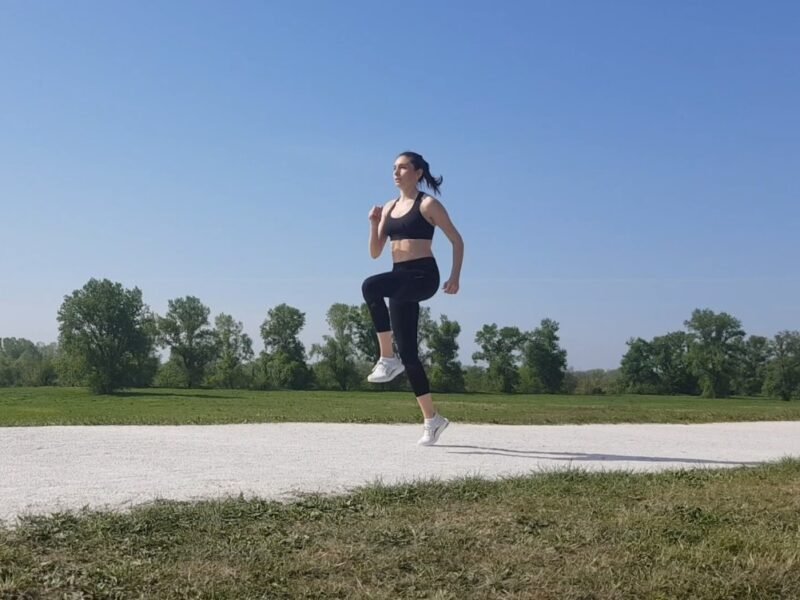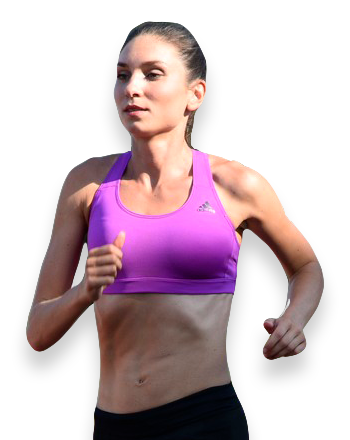How To Properly Do High Knees Drill? (Step-by-Step)
What are high knees?
High knees are a high-intensity cardio exercise runners use to warm up before more intensive training and races. The exercise improves the running technique by imitating typical running movements used in running at maximum speed. It also strengthens the hip flexor, core, and leg muscles.
How to do high knees properly?
- Begin by standing with your feet hip-distance apart, look straight ahead, and keep your upper body straight.
- Raise your left leg to hip height while standing on the ball of your right foot.
- Hit the ground below your center of mass with the ball of your left foot while raising your right leg to hip height.
- Continue alternating sides and moving forward.
Your arms should follow your leg movements, as they do when you are running.
As you are doing the high knees your foot should be bent towards your shin (dorsiflexion).
Tips for performing high knees properly
- Focus on hitting the ground, not on raising your knees.
- Mind your posture. Keep your body straight; do not bend forward or backward.
- Be careful not to hit the ground with your heel because high knees are performed on the balls of your feet.
- Do not forget to move your arms. Swing the arm opposite the raised leg.
It is important to focus on the proper execution of high knees.
If you are not able to maintain proper form, it would be better to do fewer repetitions or even stop completely.
Not doing high knees properly will ruin your running technique and increase the risk of injury as a result.
If you are not sure whether you are doing high knees properly, it is advisable to do it while being watched by the coach.
If that is not an option, then ask another runner to observe you or record yourself so that you can see whether you are performing the exercise properly.
Read more: Top 8 Running Drills To Improve Your Form [Video]
How to learn high knees?
High knees, like all other running drills, require skill and are not easy to master.
Be persistent as you learn. Start with easier and simpler exercises, slowly moving up to the more complex ones.
High knees are a challenging running drill that requires strength and coordination, and as such, I would not recommend it to beginners.
If you are a beginner then pick less challenging running drills, high knee march, and A-skip.
These running drills simulate the movements used in high knees. After you master those two drills move on to high knees.
High knee march and A-skip are exercises that improve your posture, teach you to raise your knees, and improve arm and leg coordination.
How to do the high knee march properly?
- Begin by standing with your feet hip-distance apart, look straight ahead, and keep your upper body straight.
- Step with your left foot by raising your knee to hip height while standing on your right leg.
- Lower your left foot below your center of mass.
- Raise your right foot and repeat the movement.
- Continue alternating sides and moving forward.
Your arms should follow your leg movements, as they do when you are running.
As you are doing the high knee march your foot should be bent towards your shin (dorsiflexion).
How to do the A-skip properly?
- Begin by standing with feet hip-distance apart, look straight ahead, and keep your upper body straight.
- Raise your left leg to hip height while skipping on the ball of your right foot.
- Hit the ground below your center of mass with the ball of your left foot and stand on both feet.
- Continue alternating sides and moving forward.
Your arms should follow your leg movements, as they do when you are running.
As you are doing the A-skip your foot should be bent towards your shin (dorsiflexion).
What muscles do high knees target?
High knees activate more than one muscle group. High knees target the following muscles:
- Quadriceps
- Glutes
- Hip flexors
- Hamstring
- Calf muscles
- Tibialis anterior
- Core muscles
High knees benefits
Besides being part of a warm-up routine before more intensive training or races, high knees also have other benefits.
1. Improves running technique and running economy
High knees are a running drill that teaches you to raise your knees high so that you can hit the ground with more force.
The more force you hit the ground, the higher the knee will rise in the next step and the harder you will be able to hit the ground again.
High knees also teach you the proper foot position during a run.
The foot should be bent towards the shin, in the position of dorsiflexion. Dorsiflexion enables the activation of calf muscles.
As you hit the ground the calf muscles will contract, allowing you to hit the ground with more force.
High knees also teach you not to overstride by making you hit the ground below you.
When you overstride, you hit the ground in front of you, which increases the restoring force and slows you down.
To maintain speed, you then have to spend more energy than you would if you were using a proper stroke technique.
Since there is no slowdown you will also increase your running cadence (number of steps in a minute).
Research has shown that increasing cadence by 10% reduces the stress on your knees by 5%. This reduces the risk of usual runner injuries, such as hip or knee injuries.
2. Improves neuromuscular effectiveness
High knees improve communication between nerves and muscles by quickening nerve impulses that send signals to muscle fibers.
As a result, your muscles will have better coordination in more intensive training or race.

3. Strengthens hip flexor, core, and leg muscles
High knees allow you to control running movements by strengthening the hip flexor, core, and leg muscles.
Hip flexors allow you to raise your knees to your chest as well as bend your upper body forward. Numerous runners stretch their flexors while forgetting that they need to be strengthened as well.
Research has shown that weaker hip flexor muscles lead to injury. Injuries happen not only because we forget to strengthen our hip flexors, but also because we weaken them and shorten them through everyday actions.
A strong core is key for controlling running movements. It ensures the force from the swings of your arms is properly transferred to your legs, thus improving your running economy.
Leg muscles are among the key muscles for running. The stronger the leg muscles the more energy you can produce and the faster you will be able to run.
4. Reduces contact with the ground
High knees teach you to run on the balls of your feet which reduces the time you are in contact with the ground, thus increasing your speed.
In 2007 scientists from the Ryukoku University in Japan set up a high-tech camera on the 15-kilometer-section of the half marathon and used it to record 283 runners.
Research has shown that an average midfoot striker spends 183 milliseconds in contact with the ground, while an average heel striker spends 200 milliseconds in contact with the ground.
A shorter time of contact results in a faster run and higher running economy.
5. Helps you lose weight
High knees are an exercise used in other sports as well because it is a high-intensity exercise that burns a high number of calories.
Info
A person of 155 pounds will lose approximately 6-9 calories after a minute of high knees.
Improves cardiovascular condition
High knees, like any other running drill, increase the blood flow in your muscles, thus raising muscle temperature.
At higher temperatures, hemoglobin in erythrocytes releases oxygen more quickly (Bohr effect).
This means that you will be able to handle more exertion because your blood and oxygen have an easier time traveling through your organism.
Research has shown that proper warm-up results in a 2-3% increase in body temperature, lasting 45 minutes. The increase in temperature causes useful changes in muscles and tendons:
- Significantly increases muscle elasticity and allows higher-intensity training.
- Muscles and tendons become more flexible which makes stretching muscles and tendons easier and more effective.
- A rise in enzymes and metabolic activity improves the effectiveness of muscle contractions.
Read more: Top 10 High Knees Benefits
How and when to include high knees in your training?
High knees are a running drill used in warm-up routines before more intensive training or races.
Also, you can use it after an easy jog, when you are not as tired, so you can focus on the proper execution of the exercise.
High knees can be done in place or by moving forward 20 to 40 meters and then resting as you walk back to your starting position.
Example of a warm-up routine before interval training (8 x 400m)
1. Easy jogging (10 minutes)
2. Mobility exercises and dynamic stretches (6 minutes)
3. Running drills – 2 x 40m ankling, 2 x 40m high knees, 2 x 40m butt kicks
4. Strides – 3 x 60m
Read more: Warm-up Before Running [Ultimate Guide]

Matea Matošević
Hi, I’m Matea! I’m an Olympic Marathon Runner, founder, and writer behind OLYRUN.com. On this site, I provide help in the form of my knowledge and experience to all who love running and active living. Read more…

